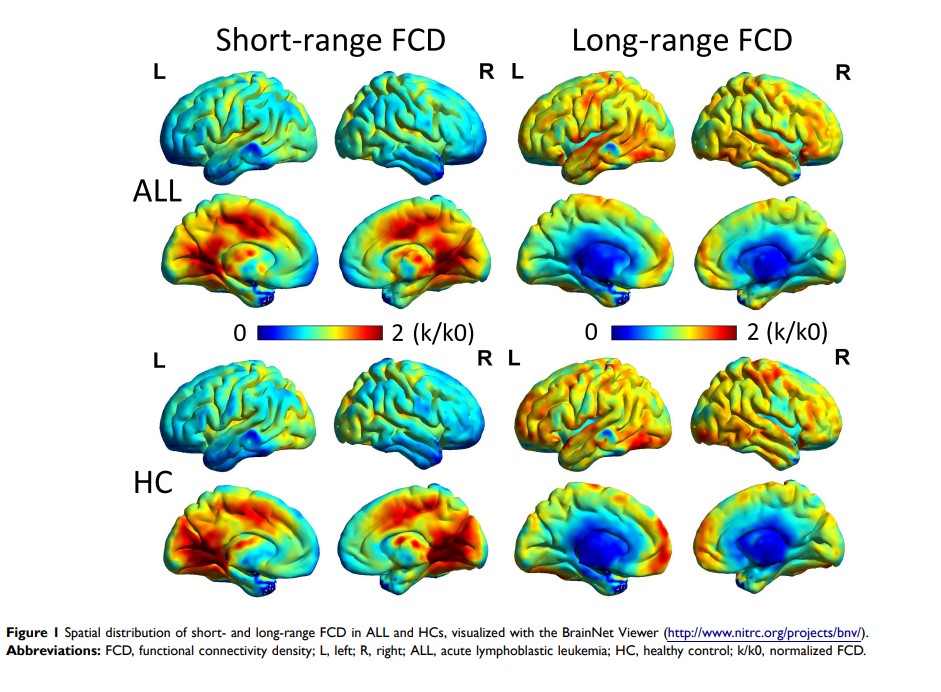100417
论文已发表
注册即可获取德孚的最新动态
IF 收录期刊
- 3.3 Breast Cancer (Dove Med Press)
- 3.4 Clin Epidemiol
- 2.5 Cancer Manag Res
- 2.9 Infect Drug Resist
- 3.5 Clin Interv Aging
- 4.7 Drug Des Dev Ther
- 2.7 Int J Chronic Obstr
- 6.6 Int J Nanomed
- 2.5 Int J Women's Health
- 2.5 Neuropsych Dis Treat
- 2.7 OncoTargets Ther
- 2.0 Patient Prefer Adher
- 2.3 Ther Clin Risk Manag
- 2.5 J Pain Res
- 2.8 Diabet Metab Synd Ob
- 2.8 Psychol Res Behav Ma
- 3.0 Nat Sci Sleep
- 1.8 Pharmgenomics Pers Med
- 2.7 Risk Manag Healthc Policy
- 4.2 J Inflamm Res
- 2.1 Int J Gen Med
- 4.2 J Hepatocell Carcinoma
- 3.7 J Asthma Allergy
- 1.9 Clin Cosmet Investig Dermatol
- 2.7 J Multidiscip Healthc

使用静息态功能磁共振成像探测急性淋巴细胞白血病年轻幸存者的功能连接密度改变
Authors Chen L, Zhan Y, He F, Zhang S, Wu L, Gong H, Zhou F, Zeng X, Xu H
Received 10 March 2020
Accepted for publication 7 July 2020
Published 7 August 2020 Volume 2020:12 Pages 7033—7041
DOI https://doi.org/10.2147/CMAR.S253202
Checked for plagiarism Yes
Review by Single anonymous peer review
Peer reviewer comments 3
Editor who approved publication: Dr Kenan Onel
Objective: Using functional connectivity density (FCD) mapping measured by resting-state functional magnetic resonance imaging (rs-fMRI), an ultrafast data-driven graph theory approach, we attempted to study the abnormalities in neural activity of young survivors of acute lymphoblastic leukemia (ALL) and to explore the neuropathological evidence of chemotherapy-related cognitive impairment of patients.
Methods: Twenty young survivors of ALL and 18 well-matched healthy controls (HCs) were recruited in this study. All ALL patients and healthy controls underwent rs-fMRI scans and completed neurocognitive testing. The between-group differences in short-range and long-range FCD were calculated by the option of degree centrality (DC) in MATLAB software after preprocessing. The correlations between the FCD value and each of the neurocognitive outcomes were analyzed in the ALL patients.
Results: The group-averaged FCD maps showed similar spatial patterns between the two groups. Compared with the HCs, ALL patients showed decreased long-range FCD in regions of the bilateral lingual gyrus, cingulate cortex, hippocampal gyrus, and right calcarine fissure. Simultaneously, decreased regions in the short-range FCD map were the bilateral lingual gyrus, cingulate cortex, parahippocampal gyrus and right calcarine fissure. Increased functional connectivity (FC) was observed between the region with decreased long-range FCD and the posterior cerebellar lobe, and decreased FC was observed between the region and the middle occipital gyrus, cuneus and lingual gyrus. Thus, there existed no brain areas with increased FCD. The decreased short-range FCD value of ALL patients was positively correlated with the score on the Digit Span Test (Forward), and the increased FC value was negatively correlated with the score on the Trail Making Test part A.
Conclusion: Our results suggest the altered functional connectivity of young survivors of ALL in the posterior region of the brain and posterior lobe of the cerebellum. Alterations in spontaneous neuronal activity seem to parallel the neurocognitive testing, which indicates that the rs-fMRI could be used as a neuroimaging marker for neurological impairment in ALL patients.
Keywords: acute lymphoblastic leukemia, resting-state fMRI, functional connectivity density, chemotherapy-related cognitive impairment, executive function
